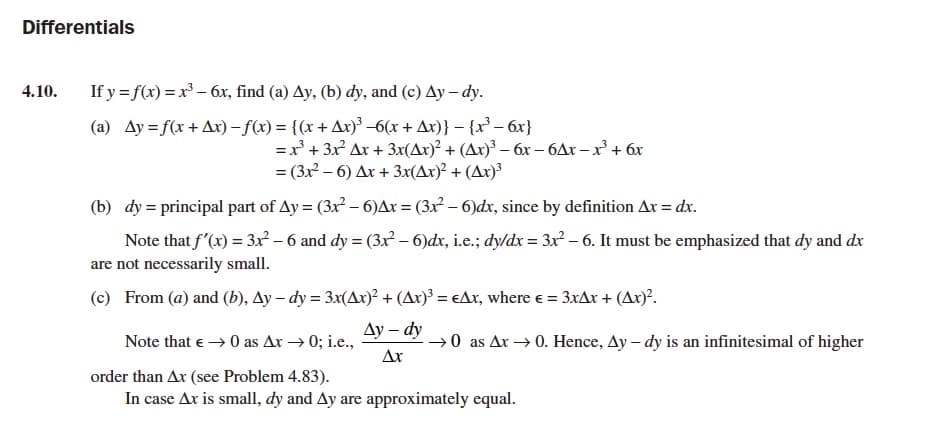4.10. If y = f(x) = x – 6x, find (a) Ay, (b) dy, and (c) Ay – dy. (a) Ay = f(x + Ax) – f(x) = {(x + Ax)³ –6(x + Ax)} – {x³ – 6x} =x + 3x Ax + 3x(Ax)² + (Ax)³ – 6r – 6Ax – x+ 6x = (3x – 6) Ax + 3x(Ax)² + (Ax)³ (b) dy = principal part of Ay = (3x – 6)Ax = (3x - 6)dx, since by definition Ax = dx. Note that f'(x) = 3x² - 6 and dy = (3x – 6)dx, i.e.; dy/dx = 3x? - 6. It must be emphasized that dy and dx are not necessarily small. (c) From (a) and (b), Ay – dy = 3x(Ax)² + (Ax)³ = €Ax, where e = 3xAx + (Ax)².
4.10. If y = f(x) = x – 6x, find (a) Ay, (b) dy, and (c) Ay – dy. (a) Ay = f(x + Ax) – f(x) = {(x + Ax)³ –6(x + Ax)} – {x³ – 6x} =x + 3x Ax + 3x(Ax)² + (Ax)³ – 6r – 6Ax – x+ 6x = (3x – 6) Ax + 3x(Ax)² + (Ax)³ (b) dy = principal part of Ay = (3x – 6)Ax = (3x - 6)dx, since by definition Ax = dx. Note that f'(x) = 3x² - 6 and dy = (3x – 6)dx, i.e.; dy/dx = 3x? - 6. It must be emphasized that dy and dx are not necessarily small. (c) From (a) and (b), Ay – dy = 3x(Ax)² + (Ax)³ = €Ax, where e = 3xAx + (Ax)².
Calculus: Early Transcendentals
8th Edition
ISBN:9781285741550
Author:James Stewart
Publisher:James Stewart
Chapter1: Functions And Models
Section: Chapter Questions
Problem 1RCC: (a) What is a function? What are its domain and range? (b) What is the graph of a function? (c) How...
Related questions
Concept explainers
Equations and Inequations
Equations and inequalities describe the relationship between two mathematical expressions.
Linear Functions
A linear function can just be a constant, or it can be the constant multiplied with the variable like x or y. If the variables are of the form, x2, x1/2 or y2 it is not linear. The exponent over the variables should always be 1.
Question
4.10) my professor says I have to explain the steps in the solved problems in the picture. Not just copy eveything down from the text.

Transcribed Image Text:Differentials
4.10.
If y = f(x) = x – 6x, find (a) Ay, (b) dy, and (c) Ay – dy.
(a) Ay = f(x + Ax) – f(x) = {(x + Ax)³ –6(x + Ax)} – {x³ – 6x}
=x' + 3x Ax + 3x(Ax)² + (Ax)³ – 6x – 6Ax – x² + 6x
= (3x – 6) Ax + 3x(Ar)² + (Ax)³
(b) dy = principal part of Ay = (3x² – 6)Ar = (3x² – 6)dx, since by definition Ax = dx.
Note that f'(x) = 3x – 6 and dy = (3x – 6)dx, i.e.; dy/dx = 3x² – 6. It must be emphasized that dy and dx
are not necessarily small.
(c) From (a) and (b), Ay – dy = 3x(Ax)² + (Ax)³ = €Ax, where e = 3xAx + (Ax)'.
Ду — dy
Note that e → 0 as Ar → 0; i.e.,
→0 as Ar → 0. Hence, Ay – dy is an infinitesimal of higher
Ar
order than Ax (see Problem 4.83).
In case Ax is small, dy and Ay are approximately equal.
Expert Solution
This question has been solved!
Explore an expertly crafted, step-by-step solution for a thorough understanding of key concepts.
Step by step
Solved in 4 steps

Knowledge Booster
Learn more about
Need a deep-dive on the concept behind this application? Look no further. Learn more about this topic, calculus and related others by exploring similar questions and additional content below.Recommended textbooks for you

Calculus: Early Transcendentals
Calculus
ISBN:
9781285741550
Author:
James Stewart
Publisher:
Cengage Learning

Thomas' Calculus (14th Edition)
Calculus
ISBN:
9780134438986
Author:
Joel R. Hass, Christopher E. Heil, Maurice D. Weir
Publisher:
PEARSON

Calculus: Early Transcendentals (3rd Edition)
Calculus
ISBN:
9780134763644
Author:
William L. Briggs, Lyle Cochran, Bernard Gillett, Eric Schulz
Publisher:
PEARSON

Calculus: Early Transcendentals
Calculus
ISBN:
9781285741550
Author:
James Stewart
Publisher:
Cengage Learning

Thomas' Calculus (14th Edition)
Calculus
ISBN:
9780134438986
Author:
Joel R. Hass, Christopher E. Heil, Maurice D. Weir
Publisher:
PEARSON

Calculus: Early Transcendentals (3rd Edition)
Calculus
ISBN:
9780134763644
Author:
William L. Briggs, Lyle Cochran, Bernard Gillett, Eric Schulz
Publisher:
PEARSON

Calculus: Early Transcendentals
Calculus
ISBN:
9781319050740
Author:
Jon Rogawski, Colin Adams, Robert Franzosa
Publisher:
W. H. Freeman


Calculus: Early Transcendental Functions
Calculus
ISBN:
9781337552516
Author:
Ron Larson, Bruce H. Edwards
Publisher:
Cengage Learning